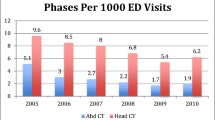Abstract
The Emergency Department is a risk-laden environment for clinicians caring for children. A number of factors can increase the risk of medical errors and adverse events, including lack of standardized medication dosing because of size variation in the pediatric age range, unique physical and developmental characteristics of children that affect treatment strategies, and the inability of young or non-verbal children to provide a medical history or to clearly communicate pain and other symptoms. The Emergency Department (ED) setting is often hectic and chaotic, with lots of interruptions. Many EDs lack the pediatric-specific supplies deemed essential for managing pediatric emergencies, and long hours or overnight shifts, while necessary for maintaining 24-hour emergency services, can cause provider fatigue that can lead to increased medical errors. It is in this environment that ED physicians make decisions about the use of CT scans in children, often without evidence-based guidelines to help them weigh risks and benefits. Although recent efforts have raised the awareness of the risk of exposure to radiation, many pediatric providers and families lack adequate information to guide decisions about the use of CT. Pediatricians and emergency physicians need to collaborate with radiologists to maintain current knowledge of the risks and benefits of CT scans, to advocate for pediatric protocols and evidence-based guidelines, and to engage families in decisions regarding the evaluation and treatment of pediatric patients in the Emergency Department.
Similar content being viewed by others
References
Kohn HT, Corrigan JM, Donaldson MS (2000) To err is human: building a safer health system. National Academies Press, Washington
Pronovost PF, Wachter RM (2014) Progress in patient safety: a glass fuller than it seems. Am J Med Qual 29:165–169
Institute of Medicine Committee on the Future of Emergency Care in the United States Health System (2006) Hospital-based emergency care: at the breaking point. National Academies Press, Washington, DC
Institute of Medicine Committee on the Future of Emergency Care in the United States Health System (2006) Emergency care for children: growing pains. National Academies Press, Washington
AAP Committee on Pediatric Emergency Medicine, Krug S, Frush K (2007) Patient safety in the pediatric emergency care setting. Pediatrics 120:1367–1375
Joint Commission Resources (2010) American Academy of Pediatrics. In: Krug SE (ed) Pediatric patient safety in the emergency department. Joint Commission Resources, Oakbrook Terrace
Miller MR, Pronovost PJ, Burstin HR (2004) Pediatric patient safety in the ambulatory setting. Ambul Pediatr 4:47–54
Slonim AD, LaFleur BJ, Ahmed W et al (2003) Hospital-reported medical errors in children. Pediatrics 111:617–621
Lannon CM, Koven BJ, Lane France F et al (2001) Principles of patient safety in pediatrics. Pediatrics 107:1473–1475
Chamberlain JM, Slonim AD, Joseph JG (2004) Reducing errors and promoting safety in pediatric emergency care. Ambul Pediatr 4:55–63
Joffe MD (2006) Emergency department provider fatigue and shift concerns. Clin Pediatr Emerg Med 7:248–254
(1998) Special report on sentinel events. Joint commission on accreditation of healthcare organizations. Jt Comm Perspect 18:19–33, 36–42
Morey JC, Simon R, Jay GD et al (2002) Error reduction and performance improvement in the emergency department through formal teamwork training: evaluation results of the MedTeams project. Health Serv Res 37:1553–1581
Cohen AL, Rivara F, Marcuse EK et al (2005) Are language barriers associated with serious medical events in hospitalized pediatric patients? Pediatrics 116:575–579
Larson DB, Johnson LW, Schnell BM et al (2011) Rising use of CT in child visits to the emergency department in the United States, 1995–2008. Radiology 259:793–801
Kocher KE, Meurer WJ, Fazel R et al (2011) National trends in use of computed tomography in the emergency department. Ann Emerg Med 58:452–462
Townsend BA, Callahan MJ, Zurakowski D et al (2010) Has pediatric CT at children’s hospitals reached its peak? AJR Am J Roentgenol 194:1194–1196
Faul M, Xu L, Wald MM et al (2010) Traumatic brain injury in the United States: emergency department visits, hospitalizations and deaths 2002–2006. Centers for Disease Control and Prevention, National Center for Injury Prevention and Control, Atlanta, GA
Brain Injury Association. http://www.biausa.org/brain-injury-children.htm#Incidence. Accessed 8 July 2014
Kuppermann N, Holmes JF, Dayan PS et al (2009) Identification of children at very low risk of clinically important brain injuries after head trauma: a prospective cohort study. Pediatric Emergency Care Applied Research Network (PECARN). Lancet 374:1160–1170
Holmes JF, Lillis K, Monroe D et al (2013) Identifying children at very low risk of clinically important blunt abdominal injuries. Pediatric Emergency Care Applied Research Network (PECARN). Ann Emerg Med 62:107–116
Frush DP, Frush KS, Oldham K (2009) Imaging of acute appendicitis in children: EU vs US … or US vs CT? A North American perspective. Pediatr Radiol 39:500–505
Doria AS, Moineddin R, Kellenberger CJ et al (2006) US or CT for diagnosis of appendicitis in children and adults? A meta-analysis. Radiology 241:83–94
Broder JS (2011) Radiation risks from diagnostic computed tomography in the emergency department. Ann Emerg Med 57:309–310
Awé C, Lin SJ (2003) A patient empowerment model to prevent medication errors. J Med Syst 27:503–517
Berwick DM (2009) What ‘patient-centered’ should mean: confessions of an extremist. Health Aff 28:w555–w565
Conflicts of interest
Dr. Frush has no financial interests, investigational or off-label uses to disclose.
Author information
Authors and Affiliations
Corresponding author
Rights and permissions
About this article
Cite this article
Frush, K. Why and when to use CT in children: perspective of a pediatric emergency medicine physician. Pediatr Radiol 44 (Suppl 3), 409–413 (2014). https://doi.org/10.1007/s00247-014-3122-x
Received:
Revised:
Accepted:
Published:
Issue Date:
DOI: https://doi.org/10.1007/s00247-014-3122-x



